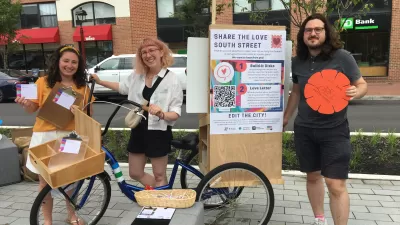Zelda Bronstein makes plenty of points likely to inspire disagreement among planners in this argument calling for a better form of public engagement—one that's substantive and integral, not an afterthought.
Zelda Bronstein expresses frustration with the public outreach process of the San Francisco Planning Department as it considers the Railyard Alternatives and I-280 Feasibility Study. The feasibility study is examining "a proposal to take down I-280 and re-route the former freeway traffic on a boulevard through the neighborhoods, are massive and controversial."
Bronstein acknowledges the controversy inherent in such a drastic proposal, but focuses most intently on the Planning Department's outreach efforts to far, two years into the $1.7 million study. According to Bronstein, a February 23 event "was the first time the community had a chance to weigh in on the project—and the chance it had was paltry."
Bronstein proceeds to describe the format of the presentation as a "Science Fair," by which city planners "mute the public's say in public policy—all while purporting to enhance civic engagement." These practices are not unique to San Francisco or this plan, argues Bronstein, but a symptom, as the headline of the article reads, of planners treating "us like infants."
As an alternative to the "Science Fair" format, and to the pop-up format described in this Planetizen blog post by Dave Briggs (addressed specifically in Bronstein's article), Bronstein suggests that members of the public should be treated equally as the planning officials and other dignitaries working behind closed doors.
FULL STORY: When city planners treat us like infants

Study: Maui’s Plan to Convert Vacation Rentals to Long-Term Housing Could Cause Nearly $1 Billion Economic Loss
The plan would reduce visitor accommodation by 25,% resulting in 1,900 jobs lost.

North Texas Transit Leaders Tout Benefits of TOD for Growing Region
At a summit focused on transit-oriented development, policymakers discussed how North Texas’ expanded light rail system can serve as a tool for economic growth.

Why Should We Subsidize Public Transportation?
Many public transit agencies face financial stress due to rising costs, declining fare revenue, and declining subsidies. Transit advocates must provide a strong business case for increasing public transit funding.

How to Make US Trains Faster
Changes to boarding platforms and a switch to electric trains could improve U.S. passenger rail service without the added cost of high-speed rail.

Columbia’s Revitalized ‘Loop’ Is a Hub for Local Entrepreneurs
A focus on small businesses is helping a commercial corridor in Columbia, Missouri thrive.

Invasive Insect Threatens Minnesota’s Ash Forests
The Emerald Ash Borer is a rapidly spreading invasive pest threatening Minnesota’s ash trees, and homeowners are encouraged to plant diverse replacement species, avoid moving ash firewood, and monitor for signs of infestation.
Urban Design for Planners 1: Software Tools
This six-course series explores essential urban design concepts using open source software and equips planners with the tools they need to participate fully in the urban design process.
Planning for Universal Design
Learn the tools for implementing Universal Design in planning regulations.
Ascent Environmental
Borough of Carlisle
Institute for Housing and Urban Development Studies (IHS)
City of Grandview
Harvard GSD Executive Education
Toledo-Lucas County Plan Commissions
Salt Lake City
NYU Wagner Graduate School of Public Service





























